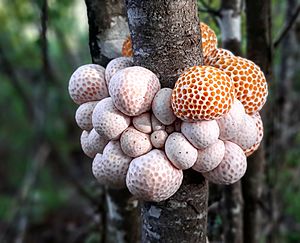Digüeñe facts for kids
Quick facts for kids Digüeñe |
|
|---|---|
 |
|
| Cyttaria espinosae from Chile growing in a tree branch | |
| Scientific classification | |
| Kingdom: | |
| Division: | |
| Class: |
Leotiomycetes
|
| Order: |
Cyttariales
|
| Family: |
Cyttariaceae
|
| Genus: |
Cyttaria
|
| Species: |
C. espinosae
|
| Binomial name | |
| Cyttaria espinosae Lloyd
|
|
Cyttaria espinosae is a special kind of fungus that grows in Chile and Argentina. People often call it digüeñe (dee-gwen-yeh). It looks like an orange-white ball and is safe to eat! You might also hear it called dihueñe, lihueñe, quireñe, pinatra, or quideñe.
What is Digüeñe?
The digüeñe is a type of fungus that lives on certain trees. It's a bit like a plant that gets its food from another plant. It mostly grows on Nothofagus trees, especially Nothofagus obliqua trees. These trees are common in south-central Chile and Argentine Patagonia.
When the digüeñe grows, it can make bumps on the tree branches. These bumps are where the fungus's spores come out. Spores are like tiny seeds that help the fungus spread. The bumpy surface helps the spores fly away easily in the wind. This way, new digüeñe fungi can grow on other trees. You can usually see them appear between spring and early summer.
How is Digüeñe Used?
The digüeñe has a taste that is often described as a mix between sweet and plain. In the Patagonia region, people often eat digüeñe fresh in salads. They also like to fry it with scrambled eggs to use as a filling for empanadas. The Mapuche people have traditionally eaten digüeñe for a long time.
See also
 In Spanish: Digüeñe para niños
In Spanish: Digüeñe para niños

